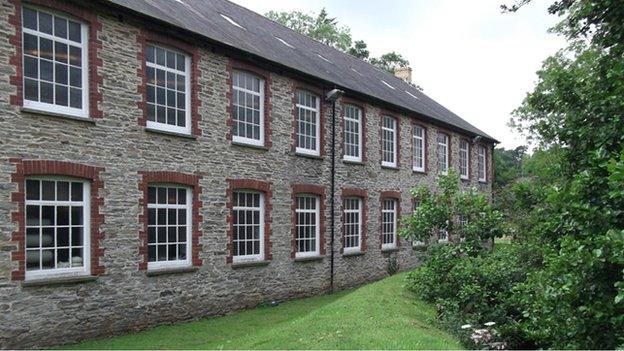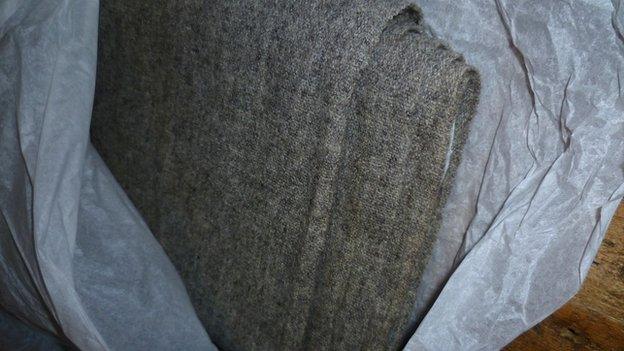World War One: Problem-hit uniform gave Welsh troops own identity
- Published

Cambrian Mill in Carmarthenshire was one of the locations where the uniforms were made
On Saturday 19 September 1914, Chancellor of the Exchequer David Lloyd George set out his vision for a Welsh army corps in a typically stirring and patriotic speech.
The Corps was to have fought alongside - but be distinct from - the English army, have Welsh-speaking officers, and most importantly of all, it should have had its own highly identifiable uniform of homespun Welsh Grey, or Brethyn Llwyd cloth.
On the face of it the plan was a disaster, with 13 Welsh mills contracted to produce the Brethyn Llwyd cloth, and each coming up with their own shade of grey.
In fact, the uniforms produced for the 11th Battalion Welsh Regiment by outfitters Messrs' Jotham of Cardiff were so brown that it led to the unit becoming nicknamed "The Chocolate Soldiers".
Supply problems hit the project from the outset, and fewer than 9,000 Brethyn Llwyd uniforms were ever produced for the 50,000 Welsh volunteers.
By May 1915 cost-cutting had seen Lloyd George's unique Welsh Army Corps entirely subsumed into the structure of the regular British Army, with the Welsh Grey colours having never made it into battle.
Mark Lucas, curator of The Welsh National Wool Museum at the former Cambrian Mill in Dre-fach Felindre, Carmarthenshire, explained that organisers seem to have backed the wrong sheep from the outset.
'Uniform delays'
"There were so many variations in the colours produced because Brethyn Llwyd was made from the wool of black sheep, which was much more scarce than wool from a white sheep," he said.
"So mills were each forced to experiment with their own compositions and manufacturing processes.
"But as well as being harder to get hold of, wool from a black sheep was also much more expensive," he added.

Only this piece of Brethyn Llwyd cloth is believed to have survived
It all led to shambolic shortages and delays in getting uniforms to Welsh regiments.
As late as April 1915 many recruits were parading in their own clothes, while others had to make do with surplus postmen's uniforms.
Even though the administration of Brethyn Llwyd faced problems from the start, in an essay to mark last year's Welsh History Month, Aberystwyth University historian, Dr Robin Barlow, argued its concept was one of the most brilliant in 20th Century Welsh history.
"Although the Welsh Army Corps (WAC) never achieved its aim of clothing as many of the troops as possible in uniforms of native homespun cloth, the decision to use Brethyn Llwyd did allow the WAC to claim the distinctiveness of a special uniform, produced in Wales, for Welsh soldiers," he said.
"Perhaps most importantly, the WAC provided a great boost to recruitment from a nation which was traditionally antagonistic towards the 'English' Army".
Indeed, by the end of 1915 more than 50,000 men had volunteered for what was to become the 38th (Welsh) Division.
'Separate identity'
Dr Gerry Oram of Swansea University, who has written a paper on Welsh recruitment during WW1, believes the Brethyn Llwyd concept was a key factor in making this happen.
"At the start of the war many in Wales were trade unionists and some even saw themselves as international socialists, opposed to the struggle between two imperial powers like England and Germany. There is a widespread attitude of 'Active Neutrality'," he said.
"Furthermore, in 1912 [Labour MP] Keir Hardie had even felt compelled to raise in parliament the fact that the Merthyr Territorials hadn't even been trusted with their own weapons by the regular army during industrial disputes.
"There was, therefore, considerable antipathy towards the military in Wales."
He added that what Lloyd George did so brilliantly with Brethyn Llwyd was to appeal to a sense of Welsh identity.
"Those very things which Welshmen perceived as making them different were rallying cries for Lloyd George.
"Appealing to 'The Five Foot Five Nation', and 'The race that faced the Normans for centuries' was a work of genius, but the uniforms would have given that separate identity a physical form."
Hear more about how mills answered the call for Brethyn Llwyd.
- Published26 February 2014
- Published27 February 2014
- Published27 July 2013
- Published25 February 2014
- Published24 February 2014